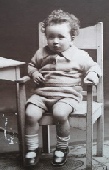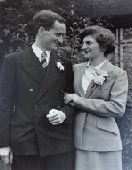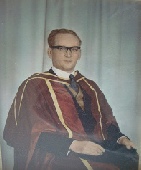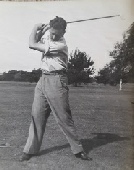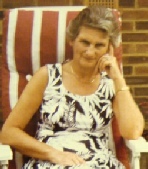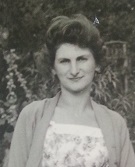They had a son, John, who was baptized at Winchfield (Hampshire) Parish Church on 12th June 1709. They then migrated further south to Bramshott (Hampshire) which is on the Surrey/Sussex borders. Evidence for the migration of the Girdlers south to Bramshott is given in the Branshott Parish Records as follows: -
Ann, daughter of John Girdler of Eversley parish, bap. 12th Jan. 1712
They had 5 more children in Bramshott - Sarah (b. 12th Feb 1714), Elizabeth (b. 2nd March 1716), Thomas (b. 19th Sept. 1722), William (b. 13th June 1725), and James (b. 8th Feb. 1729). There are many records in the Overseers' Accounts and Rate Books for the period 1722-1788 in Bramshott Parish that give an interesting account of the life history of John and Mary Girdler. The story begins in October 1724 when John Girdler received £2-1O-O for his annual house rent, followed by a similar sum in April 1726. This shows that John and Mary Girdler were on hard times and having to receive assistance from the parish. This assistance continued, but the house rent assistance appears to have been reduced from £2-10-0 per annum to £2-O-O around 1728-9.
In 1729, the Girdlers appear to have earned an extra 7s-5d for "minding" a certain Henry Cumber and providing a hat and cloth for him. There is no indication as to who this Henry Cumber was, but his clothes were repaired by the Girdlers in 1730, for which they received another 4s-Od from the parish funds. It appears that from 1730 onwards, John Girdler carried out certain duties from time to time assisting the parish constable. He was thus paid 6s-Od in December 1730 for escorting a Daniel Hounsham to Winchester, presumably for trial and sentence at the Assizes. A search through the Indictment Papers at Winchester Records Office showed that Daniel Hounsham was committed on 5th November 1730 by Robert Kercher and Thomas Bates, Esquires, and charged with being an idle and disorderly person refusing to work for his wife and 5 children. (The Hounshams also have a number of entries in the Overseers' records for various payments made from 1729 for house rent, etc.) On 29th March 1731, Daniel Hounsham was escorted to Alton (prison?) and his goods were carried to "Willsons" (16s-Od paid for these two tasks) and on 8th June 1731, Daniel Hounsham was paid 15s-Od for his "sickness in prison". The sum of 1s-Od was paid on the same day for bringing Daniel Hounsham home from prison. It is interesting to note that in the Treasurers Accounts for 1732, it was stated that many prisoners died of "the smallpox" in 1732 and extra funds were allocated for their care.
During 1731-2, the Girdlers received further payments for mending Henry Cumber's clothes, for "minding" him and for providing him with a pair of breeches. It is interesting to note that John Girdler's wife, Mary, was known as "Goody" Girdler. John Girdler was still receiving assistance to pay his rent, and in 1732-3 this was paid to a Thomas Enticknap who could possibly have been his landlord.
In 1732, John Girdler was presumably still assisting the parish constable as during Mar / Apr he was paid 3s-Od for "two days journeys to enquire after ye mother of ye child" and a further 1s-Od for "carrying of her away" so that another parish could look after her. He carried out a similar duty in September of the same year, but this must have been slightly more difficult as he was paid 5s-0d for the task.
It is worth noting that in the Assessments made on the inhabitants of Bramshott "for and towards ye necessary reliefs of ye poor thereof for ye ensuing years commencing from ye 15 of Aprell 1734" Thomas Enticknap was assessed at 12s-6d for "Pasfeld". He had to pay this sum towards poor relief and was presumably living in the property now known as Passfield Farm just N. W. of Bramshott village. John could well have been living in a cottage on Passfield Farm or the Passfield Common estate (Map 1).
During the period 1735-36, John Girdler was still carrying out the same kind of duties, as he received f6-19s-1d in all "for the account of the constable" and "the vagabond monee", presumably for escorting many poor people out of the Bramshott parish boundaries and other similar duties. Another £3-15s-6d was paid to him during this period for the "passing of vagrants" and he was referred to as a Tythingman (constable or deputy constable) of Bramshott.
He received a further 5s-Od for undisclosed duties in 1738, and in 1741 he and his wife received £1-18s-Od for "tending a man at the paper mill", This could well have been as a result of an accident there.
The records show that John Girdler apparently received no assistance for house rent between 1734-41, suggesting that his circumstances were slightly improved during this period.
The Poor Law records for Bramshott finish in 1741 and no records exist for the period 1742-1764. However, the Bramshott Overseer's Account and Rate Book for 1764-1788 does exist, albeit in a very poor state of repair. A number of entries give us a further idea of the difficult life of John Girdler from 1765-66: –
In January 1765, John Girdler received £2-0-0 to pay for his annual rent and "Dame Geordler" received 12s-6d. In February 1765, John Girdler received 14s-Od "for Mary More". Why he received this money is a matter of conjecture, but it seems that Mary More was also in need of assistance and that John Girdler was collecting the money on her behalf, perhaps because she was unable to attend to receive the money herself. Four other payments of poor relief were made to John Girdler during the rest of the year, amounting to £1-7s-Od in all. His wife, Mary, died during the year and was buried at Bramshott on 6th April 1765.
1766 was indeed a very difficult year for the Girdlers. John Girdler had to obtain poor relief in every month of the year, amounting to £411s-9d in all. In addition to this, there was a major upheaval in the removal of his son Thomas Girdler (+wife +four children) followed by settlement disputes as to the parish responsible for their poor relief, before Thomas and family eventually settled in Funtington, Sussex. This will be described in detail later.
The period 1766-1768 was a bad one for the country in general. In 1766, there was a severe winter followed by heavy flooding, particularly in the Eastern counties. Harvesting weather was fine, but the grain was light. As prices rose, there was much discontent. The exportation of corn was prohibited. In addition, sheep rot took a heavy toll in the autumn. Although the summer of 1767 was dry with a moderately good harvest, wheat prices were still high until after the harvest and caused much unrest, 1768 was a wet year with a poor harvest, when a cold and wet spring was followed by torrential rain from June 7th, and the rain persisted until the end of the harvest. The hay and grain harvests were disappointing. September fogs were followed by frequent rain for the rest of the autumn and floods occurred in November. There were riots in many places.
During the period 1766-68 the price of wheat rose from 43s-1 d to 53s-9d per quarter (8 bushells).
Against this background, the life for John Girdler at Bramshott was very grim. During 1767, John Girdler received frequent payments of poor relief amounting to £3-9s-Od in total. This state of affairs continued during 1768, when he received assistance every month, amounting to the sum of £5-4s-Od for the whole year, and during the first 10 months of 1769 he received a total of £5-12s-6d. At this time, his health was beginning to deteriorate. During February, "widow Earle" was paid 10s-Od for "looking after John Girdler's legg" and "Dame Canterell" was given 9s-Od during April/May for looking after John Girdler for 9 weeks, which suggests that he was incapable of looking after himself at this stage, Further payments were made to Dame Canterell from June–October 1769, but there is no evidence as to whether these were for John Girdler's care or not.
John Girdler died in October 1769 and was buried at Bramshott on 12th October 1769 at the ripe old age of 87, which says much for his stamina and ability to battle on despite all the adversities he encountered during his difficult life.
Of John's children, no further records have so far been located with regard to what happened to John (b. 1709), Sarah (b. 1714), Elizabeth (b.1716) or James (b.1729). Anne (b.1712) married Richard Mortin at Bramshott Parish Church on 20th December 1939. The story regarding William (b. 1725) has, however, been investigated a little further:-
William Girdler (b. 1725) married Elizabeth Bridger and moved to Haslemere Parish in Surrey (This is the neighbouring parish to the E. of Bramshott but happens to be over the county border). They had 4 children in Haslemere - Ann (b. 21st August 1757), William (b. 18th April 1759), James (b. 17th April 1761), and Sarah (b. 12th November 1762) plus (according to his subsequent will) another daughter Elizabeth. A search through the Woods Collection at Godalming Library resulted in some interesting findings in the will of William Bridger of Chidding fold on 12th May 1758, where he bequeathed "to his niece Betty, the wife of William Girdler of the parish of Haslemere, husbandman, his messuage or tenement and barn, and the land and coppice grounds thereunto belonging, containing 26 acres, called Clamer Hill in the parish of Chidding fold, and the hedge or fence between the said lands and the lands called Stroud Lands in the parish of Witley, from the Upper Pond Head to the Lower Pond Head." Betty Girdler was to pay £150 to his niece, Sarah Diggason, otherwise Glasier, the wife of William Diggason, otherwise Glasier, of the parish of Bramshott, husbandman. Subsequent entries in the Woods Collection show that, in the Rent Rolls for Chidding fold, William Girdler paid the rent of 1s-8d for Clamer Hill during the year ending Michaelmas 1765. Betty Girdler died in 1798 and was buried on 26th February 1798. William Girdler died in 1802 at the age of 77 and a later Woods Collection entry states that "William Girdler, owner of a little farm at Grayswood in Chidding fold", was buried at Chidding fold on 12th December 1802 and left his estate to his daughter Elizabeth. This daughter married James Jones, had a son John in 1785 and purchased some freehold (2 houses + land) in Hambledon from a Mr. H. Newman in July 18O3.
Why Elizabeth was singled out as the sole beneficiary is unknown, unless all his other children had died by then. It is known that his daughter Sarah died in 1773 (aged 11) and his son William died in 1795 (aged 36). The latter William had married Fanny Buss at Haslemere Parish Church on 7th June 1784 and had three children, two of whom both died at 5 years of age. William's wife, Fanny, remarried after her husband's death - to James Pudwick (Puttick) at Frimley Parish Church on 5th May 1798.

